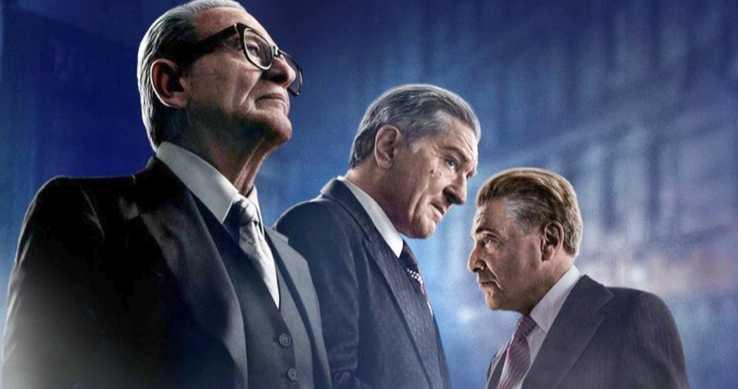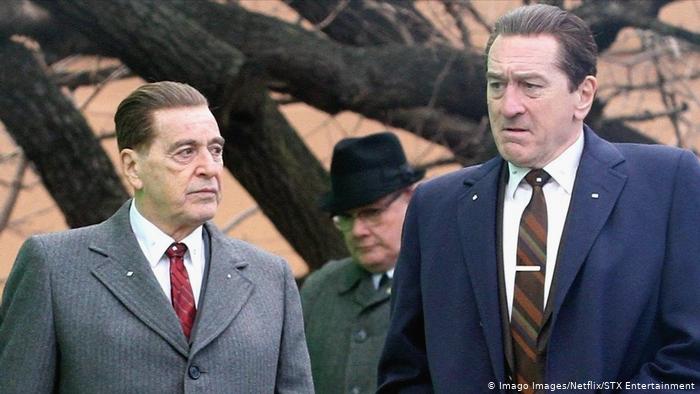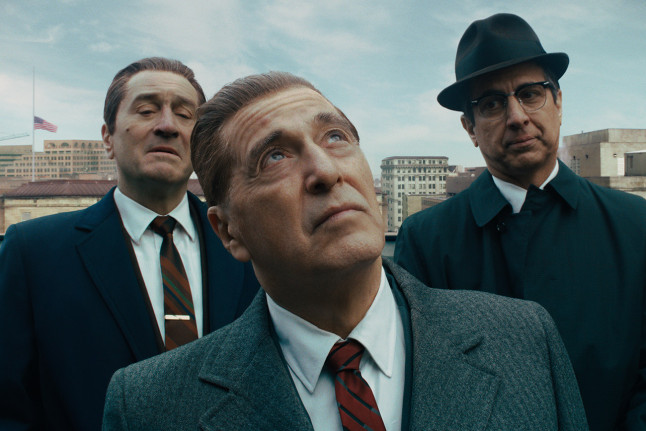
Martin Scorsese’s “The Irishman” is a three-and-a-half hour argument that Marvel superhero movies are indeed not cinema.
The 77-year-old director is the champion of great, intimate, actors engaged in exploring the human condition, often in times of extreme and dangerous circumstances. He is not interested in recreating roller coaster rides. He’s more interested in jolting you in your mind and imagination, not just in your seat.
That’s the M.O. behind “The Irishman,” streaming now on Netflix and still screening at a few neighbourhood cinemas.
Scorsese brings together his veteran murder’s row — Robert De Niro, 76, Al Pacino, 79, Joe Pesci, 75 — to tell a story spanning several decades and woven around true life events. You could not make up these characters: Frank Sheeran (De Niro), a loyal hit man and union officer); Jimmy Hoffa (Pacino), a powerful and controversial union boss; and notorious Cosa Nostra crime lord Rosario “Russell” Bufalino (Pesci).
The three leads are incredible. Nobody walks through “another crime story” here. All three are electric despite being set at widely different levels of intensity, ranging from simmering (De Niro) to volcanic (Pacino).

The story touches on a few of the greatest mysteries of the 20th Century: who killed president John F. Kennedy and what happened to Hoffa, who seemingly fell off the face of the earth at the age of 62 in 1975. That the two events are linked has long been rumoured but never confirmed. It’s all in the book on which the movie is largely based, “I Heard You Paint Houses,” by Charles Brandt.
advertisement
Scorsese’s maturity and range as a storyteller is sure handed throughout. There isn’t a single misplaced camera angle, or, despite the film’s long length, a throwaway take. In a few scenes I was surprised by what I saw as moments more reminiscent of a Woody Allen film, especially mid-movie when Pesci seems to break the fourth wall and speak directly to the camera.
The power of this movie, however, is in its performances. Just getting to watch De Niro and Pacino spar and test each other on screen is like being at some sort of heavyweight actors ringside title fight, senior division. De Niro and Pesci are engrossing together on a whole other, more intimate level, effortlessly spilling their personal bond into their characters.
The rest of the cast is pretty terrific, too, including Ray Romano, who commits and holds his own opposite De Niro as a reliable and effective crime boss attorney. Harvey Keitel is effectively brought in to add a little menace. Other supporting roles go to the usual suspects such as Bobby Cannavale and Domenick Lombardozzi. Anna Paquin, as Sheeran’s unforgiving daughter, and Jesse Plemons, as Chuckie O’Brien, are effective in minor roles. Sebastian Maniscalco get to live his dream as mafia loose cannon “Crazy” Joe Gallo.
The music score, by Robbie Robertson, helps viewers navigate through the decades. Marty Robbins’ “A White Sport Coat (and a Pink Carnation” just goes with cars with tail fins.

The film does, however, have one nagging, distracting and persistent flaw: the computer generated wizardry used to de-age the main actors. Traditionally, a movie covering the scope of this many years would rely on a mix of younger and older actors to bridge the decades. Scorsese and associates at Industrial Light and Magic — as well as at Netflix, which paid a hefty CGI bill — evidently felt that enough advances were made in the near-decade it took to bring “The Irishman” to the screen that a great actor with a lot of CGI could have the whole role to himself. This involved bringing in a posture expert to train De Niro to stand and bend like a 29-year-old, or for Pacino’s Hoffa to be more 39 that 79.
It doesn’t work. When De Niro as Sheeran goes ballistic on a store owner who was mean to his young daughter, it doesn’t look like a young, angry dad; it looks like a sixty-year-old man giving the boots to a clerk. The problem is worse if you’ve lived long enough to grow up along with De Niro and know he looked hungry and skinny in “Bang the Drum Slowly” (1973) or the first film he made with Scorsese, “Mean Streets” (released that same year) or even “Taxi Driver” (1976).
Kudos, I guess, to Scorsese and De Niro for trying it this way; seeing them fail at it is better than seeing anybody else I suppose. Still, easier for a director to be young again on a movie set than for an actor. Easier for an actor to gain and lose 40 pounds than 40 years. Makeup and effects all have their place, but this was too much.
A note on the last half hour or so of this movie. It is sad and disquieting and all too recognizable, especially if you have a parent in a long term car centre. Scenes here are shot point of view, putting all of us in a place where one is more likely to contemplate our own mortality. This is no country for old gangsters or for old actors and directors or old anybody else.
I loved the ending, and kudos to Scorsese for taking us there without rushing. One gets a sense that this great American director is edging close to the stage where, like Sheeran, he wants his door left open a crack. That he can still deliver a film such as “The Irishman” suggests he’s not ready to close it tight just yet.






